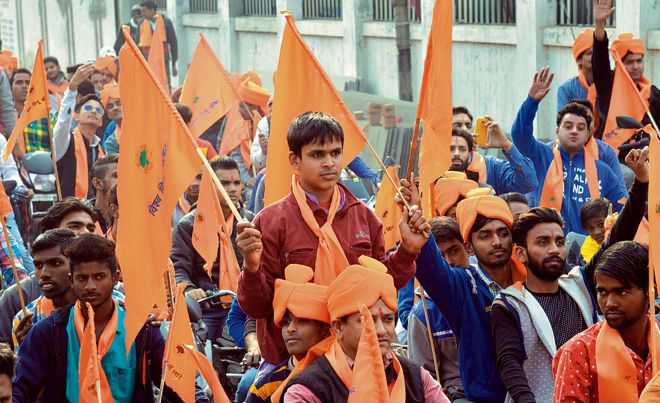
Danger mark: Bigotry in the US is finding an echo across other countries.
G Parthasarathy
Former diplomat
The collapse and disintegration of the Soviet Union led to the rejection of communist/atheistic state structures and ideologies across Europe. These developments gave a new impetus to the revival and enhancement of religious influence worldwide. Religion has now become more important on how nations think and behave, both internally and in the conduct of foreign and security policies today, than what prevailed around three decades ago. Putin, the Communist, would never have been seen near a Russian Orthodox Church. As President, he pays high respect to the Orthodox Church and clergy and is seen observing its rituals. The doctrines of Karl Marx, many claim, are in the ‘dustbin of history’, even as Samuel Huntington prophesises a doomsday ‘clash of civilisations’ across religious fault-lines.
The 9/11 terror attacks in the US by al-Qaeda terrorists, comprising largely Saudi Arabians, set the stage for a new world order, where discourse on religion, particularly on Islam, has become increasingly bigoted, especially in the US and Europe. There is little understanding that Islamic countries are largely divided along sectarian, Shia-Sunni, and civilisational, Arab-Persian lines. The approach of US President Trump and his aides presents a classic example of such thinking, with many in the US claiming that Islamic ‘values’ are contrary to those practising the Judaic-Christian faiths. Such thinking moulds US immigration and visa policies. Trump himself asserted: ‘I think Islam hates us.’ According to US analysts, ‘Islamophobia’ is now afflicting right-wing think tanks, websites and radio and television stations. American journals aver that Trump has appointed several persons afflicted by Islamophobia to key posts — Secretary of State Mike Pompeo and National Security Adviser John Bolton, for instance.
Bigotry in the US is echoed across Europe. The situation is complicated by the continuing stream of Muslim refugees, which has polarised opinion. There is growing public support for their rejection, repatriation and return. There is also a growing tendency to declare them as a threat to European traditions of tolerance, democracy and freedom. While some European countries favour banning the hijab, others like Switzerland have adopted measures like imposing a national ban on the construction of minarets. European fears about Muslim immigration have been accentuated in Belgium, the Netherlands and France, where Muslim immigrants, influenced by extremist groups like ISIS, have resorted to violence.
All this is occurring, when the Islamic world itself is being torn apart by rivalries. This has been accentuated by US-led military actions in Afghanistan, against the Taliban and in Iraq and Syria, against ISIS. These actions have dispersed, but not destroyed Al-Qaeda, Taliban, or ISIS. Expressing deep regret about the travails of Muslims and the prejudices they face, the Secretary General of the 57-member Organisation of Islamic Conference, recently noted: ‘Islamophobia has been growing strongly in the West and has continued to take root through intensive campaigns and public discourses disseminating fear of Islam, and through a significant number of incidents targeting Muslims, mosques, Islamic attire.’
India is not perceived in the eyes of the Islamic world as discriminating against Muslims, unlike the EU and US. China, however, has been ruthless in dealing with its Muslim population in its Xinjiang province, to which the Islamic world has, interestingly, turned a blind eye. While there is a debate over the term ‘secularism’ in India, we do not impose restrictions or discriminate on religious practices through actions like banning minarets, or regulating the customary attire of Muslim women. But politically, differences on minorities remain controversial. Nehru, an agnostic, was strongly opposed to the participation of Sardar Patel in actions to reopen the Somnath Temple, destroyed by Mahmud Ghazni. President Rajendra Prasad, however, refused to abide by Nehru’s advice and participated in the opening, averring: ‘I believe in my religion and cannot cut myself away from it.’
The old leftist/communist, intellectual characterisation of secularism, which amounts to abstention from religious practices and virtual agnosticism, lacks relevance. Agnosticism is no longer regarded as an electoral asset. Both Indira and Rajiv Gandhi understood the importance of religious symbolism and visited Hindu and Sufi shrines, even during poll campaigns. Renouncing his great-grandfather’s inclinations, Rahul Gandhi recently visited the Somnath Temple. The aversion he voiced to US ambassador Timothy Roemer about ‘Hindu’ terror was, however, astonishing and inexplicable. Resort to religious symbolism remains an important element of politics, protestations about secularism notwithstanding. There is, however, a taboo — sadly not observed consistently — on not appealing to voters for support in terms of their religious beliefs.
Like in most parts of the world, agnosticism has little or no place in India. What should, however, remain unacceptable is any action involving religious bigotry, use of violence or coercion, or appealing to voters in the name of religion. I have been lucky, spending all my working life in two institutions — the Army and Indian Foreign Service — where one is trained to treat all Indians, and indeed, humans equally, without religious bias. Religion and religious beliefs of members of the public have no bearing on how people and their problems are dealt with. The edifice of the national civil service institutions and judiciary, put in place by Sardar Patel and Dr Ambedkar, has functioned reasonably well for seven decades, respecting the provisions of the Constitution. Changes in structures, procedures and practices are, however, always needed to meet challenges posed by the passage of time.



























